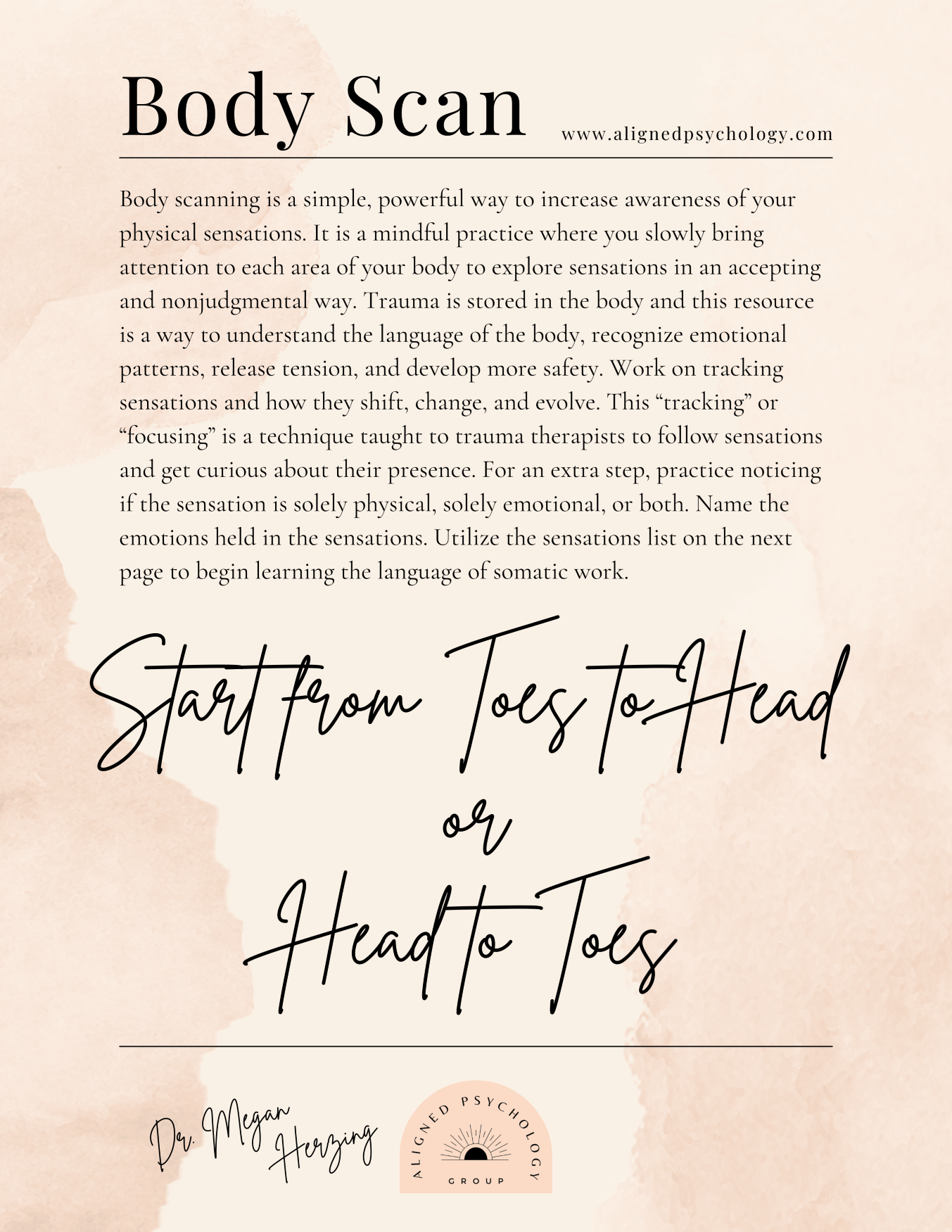Trauma Therapy Homework - Week 9
Week 9: (The Basics)
Body Scan
Welcome to Week 9 of your trauma therapy homework journey. This week, we’re diving into the practice of body scanning—a simple but powerful way to build awareness of your physical sensations. This skill can help you deepen your understanding of how emotions show up in your body, allowing you to feel more present and connected with yourself.
What Is a Body Scan?
A body scan is a mindfulness practice where you slowly bring your attention to different areas of your body, noticing sensations without judgment. The goal isn’t to change anything but to simply observe what’s happening in the present moment. This can be done from head to toe or from toe to head, depending on what feels most natural for you. Many trauma therapy modalities, including Eye Movement Desensitization and Reprocessing (EMDR) and Internal Family Systems (IFS), incorporate somatic awareness as part of the healing process. Trauma is often stored in the body, and by learning to track sensations, you can begin to recognize emotional patterns, release tension, and develop a greater sense of safety within yourself.

How to Do a Body Scan
Sit comfortably or lie down if that feels better for you. Take a few deep breaths, allowing yourself to settle into the moment. Then, begin your scan:
- Starting from the Head Down: Bring your awareness to the top of your head. Notice if there is any tension, tingling, warmth, or coolness. Move slowly down to your forehead, eyebrows, eyes, jaw, and neck. Are your eyebrows furrowed? Is your jaw tight? See if you can soften those areas just a little.
- Moving Down the Body: Bring your attention to your shoulders, arms, and hands. Do they feel heavy or light? Continue down to your chest and stomach. Is there a tightness, fluttering, or sense of openness? Move through your hips, thighs, knees, calves, and feet. Are your legs restless, achy, or relaxed? Notice whatever arises without trying to change it.
- Or, Starting from the Feet Up: Notice any tingling, pressure, or warmth. Move upward to your ankles, calves, knees, thighs, and hips. Continue scanning the torso, chest, shoulders, arms, and hands before reaching your head.
Once you get more practiced, you can do body scans in more distracting environments, like work or school. It only takes a minute or two to bring awareness to your body.
Tracking Sensations and How They Shift
Sensations aren’t static—they change, shift, and evolve. You might start out feeling tension in your shoulders, but as you bring awareness to it, the sensation might soften, move, or even intensify before it fades. This is completely normal. Tracking means noticing how these shifts happen in real-time. For example, if you feel a knot in your stomach, stay with it for a moment. Is it sharp? Dull? Does it spread outward or stay concentrated? As you observe it, you may notice it changing—becoming lighter, dispersing, or even turning into a different sensation entirely. This awareness is a key part of trauma therapy. When we can track sensations without fear, we start to build trust with our bodies again.
The Importance of Getting Specific with Sensations
Many people are used to saying, “I feel bad,” or “I feel uncomfortable,” but when we get specific about what we’re feeling physically, it helps us gain clarity. Instead of just “I feel tense,” you might say, “There’s a tightness in my chest, like a band wrapping around it.” Instead of “I feel off,” you might say, “There’s a heavy feeling in my stomach, like a rock sitting there.” The more precise we get, the better we can understand ourselves. This is why trauma therapy often incorporates somatic (body-based) awareness. Whether it’s EMDR, IFS, or other trauma-focused therapies, being able to name and locate sensations is crucial in the healing process.
Sensations and Emotions: Connecting the Dots
Once you’ve noticed a sensation, an extra step you can take is naming the emotion that might be connected to it. Maybe that tightness in your throat isn’t just physical—maybe it holds sadness, anxiety, or unshed tears. Maybe the warmth in your chest is relief, gratitude, or love. This process is similar to trauma therapy homework week one, naming and noticing emotions, except you are starting from the body, from sensation first, and then exploring emotional content that is connected. When we sit with sensation without judgment, we create space for emotions to surface naturally. Instead of pushing discomfort away, we allow it to be there with curiosity and care. This process of noticing without reacting helps regulate the nervous system and builds emotional resilience.

Physical Sensation vs. Emotional Sensation
It can be tricky to distinguish between physical and emotional sensations, especially when they overlap. Here’s a simple way to think about it:
- Physical Sensations: These come from injuries, chronic pain, illness, or body mechanics. For example, a pulled muscle in your back, a migraine, or stomach pain from indigestion.
- Emotional Sensations: These arise from feelings and are often described metaphorically. A “lump” in your throat when you’re holding back tears, a “pit” in your stomach when you feel anxious, or a “weight” on your chest when feeling grief.
- Both Together: Sometimes, they blend. Chronic pain can carry emotional distress, and emotional distress can manifest physically. A long-standing shoulder tension might hold years of stress or suppressed anger. A tight jaw might reflect a habit of holding back words.
Understanding the difference can help you respond appropriately, whether it’s seeking medical support, emotional processing, or both.

Meeting the Body’s Needs in the Moment
Once you’ve noticed a sensation, you can take small actions to support your body. Sometimes, that means simply acknowledging what you feel. Other times, a gentle intervention can be helpful:
- Hand over heart or stomach: A comforting touch can signal safety to your nervous system.
- Stretching your neck or shoulders: Releasing tension in commonly tight areas can bring relief.
- Relaxing the jaw: Let your jaw drop slightly to ease built-up pressure. Let your tongue drop from the roof of your mouth.
- Softening the eyebrows: Many people hold tension here without realizing it. Imagine lifting and releasing them.
- Taking a slow, deep breath: This simple act can bring a sense of grounding and calm.
The key is to respond with care rather than force. You’re not trying to make sensations disappear; you’re simply giving your body the support it needs.
For Those with Chronic Pain or Illness
If you live with chronic pain or illness, body scanning may feel overwhelming or even triggering. You don’t have to do this work alone. A trusted therapist can help guide you through this practice at a pace that feels safe for you. There is no right or wrong way to engage with your body, and if this practice feels too difficult, know that support is available to help you navigate it.
Understanding the Window of Tolerance
It’s important to stay within your window of tolerance while practicing body scanning. This refers to the range in which you can process and tolerate experiences without becoming overwhelmed. If you feel yourself moving outside of this window—whether into fight or flight (panic, fear, overwhelm) or freeze (numbness, dissociation)—pause and ground yourself. Trauma is only processed within this window; outside of it, we are reliving our trauma or disconnecting from it. You can assess this using a scale of distress from 0 to 10, with 7 being in the window and 8 tipping outside your window. If you feel outside your window, take a break, breathe, and stop the practice to ground yourself. You can come back to it another time or with a trusted therapist.

Sitting with Sensation with Acceptance and Nonjudgment
One of the most important parts of this practice is learning to sit with sensations as they are. Instead of labeling a sensation as “bad” or “good,” try to meet it with curiosity: “What does this feel like? Where do I notice it? Does it shift or stay the same?” This practice is about listening to your body with kindness. Trauma often teaches us to disconnect from bodily sensations because they feel overwhelming or unsafe. By reintroducing yourself to your own body in a gentle way, you build a foundation of trust. You remind yourself that sensations come and go, and you can handle them.
Final Thoughts
Body scanning is a simple but transformative practice. By taking time to notice and track sensations, you develop a deeper connection with yourself. This helps with emotional awareness, trauma healing, and nervous system regulation. Whether you use this as a stand-alone mindfulness tool or as part of trauma therapy, the ability to observe without judgment is a powerful step toward healing. So, as you go through this week, take a few moments each day to check in with your body. Notice, name, and allow. Your body holds so much wisdom—and with practice, you’ll learn to listen to it with more clarity and compassion.
FREE Downloadable Handouts
Click this
LINK
for free access to downloadable PDFs from the Trauma Therapy Homework Series. You’ll be directed to my Google Drive folder, where you can explore all the handouts created so far. You can choose between a digital format for easy viewing on your device or a printable version if you prefer a hard copy.
Here is a preview of this week's 2 handouts! Click the link above to get your own free pdf copy.



ABOUT THE AUTHOR
Dr. Megan
Megan Herzing PsyD, Licensed Professional Clinical Counselor, specializes in trauma therapy and creating a safe, supportive space for healing. She integrates evidence-based modalities, including EMDR, Internal Family Systems (IFS), somatic therapy, and Emotionally Focused Therapy (EFT), to address the mind-body connection and empower clients on their journey to wellness. With extensive experience treating complex PTSD, anxiety, attachment injuries, and dissociation, she believes in the power of self-compassion and authentic connection to facilitate lasting change. Drawing from her own healing journey, she brings empathy and lived experience to her work, honoring each client’s unique path toward growth and resilience.
Thank you for being part of a community of humans that deeply cares about healing.
We are honored that you stopped by and hope our resources will continue to bring value to your life.
We are accepting new clients in California, and referrals are always appreciated.












